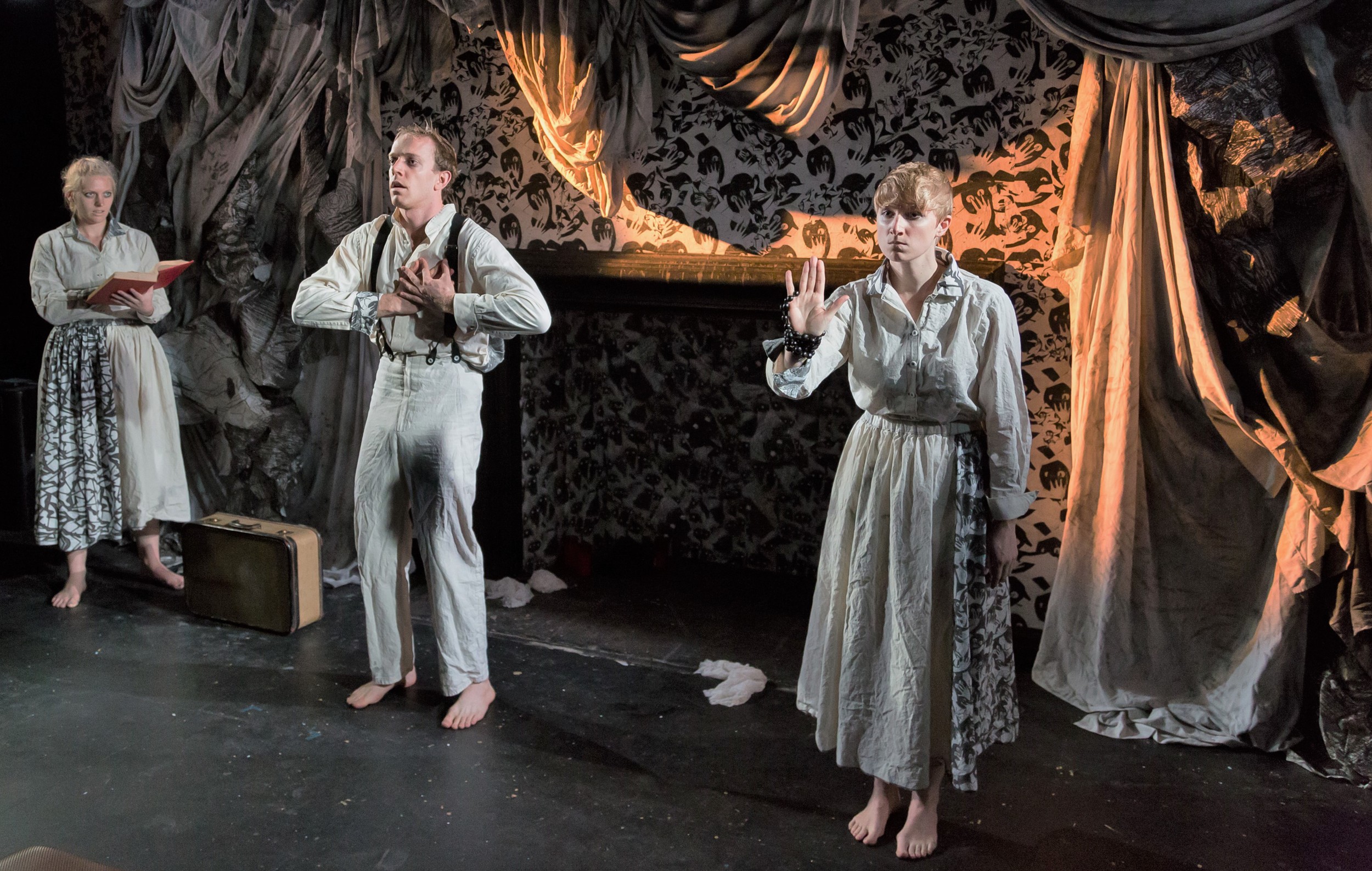Review of American Gothic at the Yale Cabaret American Gothic, the third offering by the Yale Cabaret this season, brings together three tales by renowned short story writers: Raymond Carver’s “Popular Mechanics,” (also known as “The Little Things”), Flannery O’Connor’s “A Good Man is Hard to Find,” and Jorge Luis Borges’ “El Sur” (“The South”). The show also brings together three creative disciplines: Nahuel Telleria, director and adapter (School of Drama), Sam Vernon (School of Art), and Sam Suggs (School of Music). The presentation, in front of a large curtain-like backdrop that is actually a sculpture by visual artist Vernon, presents a sense of “Gothic” as it comes down to us from Gothic fiction, with the three actors in the play—Kevin Hourigan, Libby Peterson, Jenny Schmidt—arriving gowned in hooded robes and carrying candles. Once revealed, their faces, pale with make-up, sport dark-rimmed eyes, giving a ghoulish cast to the proceedings. Suggs’ musical score is at times a fourth character, providing much of the dominant mood.
But are these stories really “Gothic” in that ghostly sense? Granted, they all three present situations that are tense with threats, with a feel for the darker, perhaps grotesque, aspects of life. But only Borges’ tale, which gets short-shrift, plot-wise, in the proceedings, is an outright “Gothic” tale, in the manner of, for instance, Poe. It’s a story of what may be a deathbed experience that becomes fraught with the kind of peril that may be mind-forged. As the closing tale, “The South,” with dramatic visual effects and voice-overs, segues into the end of the play, wherein the very production itself seems to become a phantasmagoria born of a book.
Sometimes a narrator reads from the book before the actors take over, as in the lengthiest segment, the O’Connor story, and the precise minimalism of the production, with its significant props and moody lighting by Joey Moro, works to set-off the fact that stories, even when played on stage, take place primarily in the audience’s imagination. One could say American Gothic relies on that kind of inner transformation more than most drama does.
The Carver story, because of its simplicity, comes across well as a mimed enactment of the narrative. A brief account of a couple at odds with one another that comes to focus on who will get the child, the story has the feel of a folk tale and, in its grip on a certain desperation, shows us that we’re in the world of “Southern Gothic.” The tale ends cryptically but, we assume, horribly. So move along to one of the stories that defines the genre, O’Connor’s “Good Man.”
With the cast of three taking on the five roles in the family—comprised of a married couple, their two children, and the husband’s mother—acting out the story as it's narrated, the dramatization feels a bit like “storytime.” But what a story. Hourigan, sort of insipid as the father, does a convincing transformation into “The Misfit,” a criminal at large that the family encounters after a freak accident on the road to Florida. The story has long been noted as an example of Southern Gothic with its well-detailed grasp of the persons in a certain milieu—here a somewhat dysfunctional lower middle-class family dynamic—thrown against the kind of malevolence that, real enough, feels like fatalism. O’Connor keeps a knowing grasp of her characters so that there is even grim humor in its horrific conclusion.
The special features of the show—the installation art, the score, the projections (Jon Roberts, James Lanius)—go a long way to make American Gothic an interestingly atmospheric production, though how the three tales hang together—without a Rod Serling figure putting it in a nutshell—is, perhaps fittingly, left to the viewer’s imagination.
American Gothic Conceived by Eli Epstein-Deutsch and Nahuel Telleria Directed by Nahuel Telleria
Dramaturg: David Clauson; Choreographer: Anita Shastri; Installation Artist: Sam Vernon; Costumes: Steven Rotramel; Lights: Joey Moro; Composer: Sam Suggs; Sound: Nok Kanchanabanca, Jon Roberts; Projections: Jon Roberts; Associate Projections: James Lanius; Stage Manager: Anita Shastri; Technical Director: Sam Lazar; Producers: Jason Najjoum, Libby Peterson; Production Manager: James Lanius III
Yale Cabaret October 9-11, 2014



